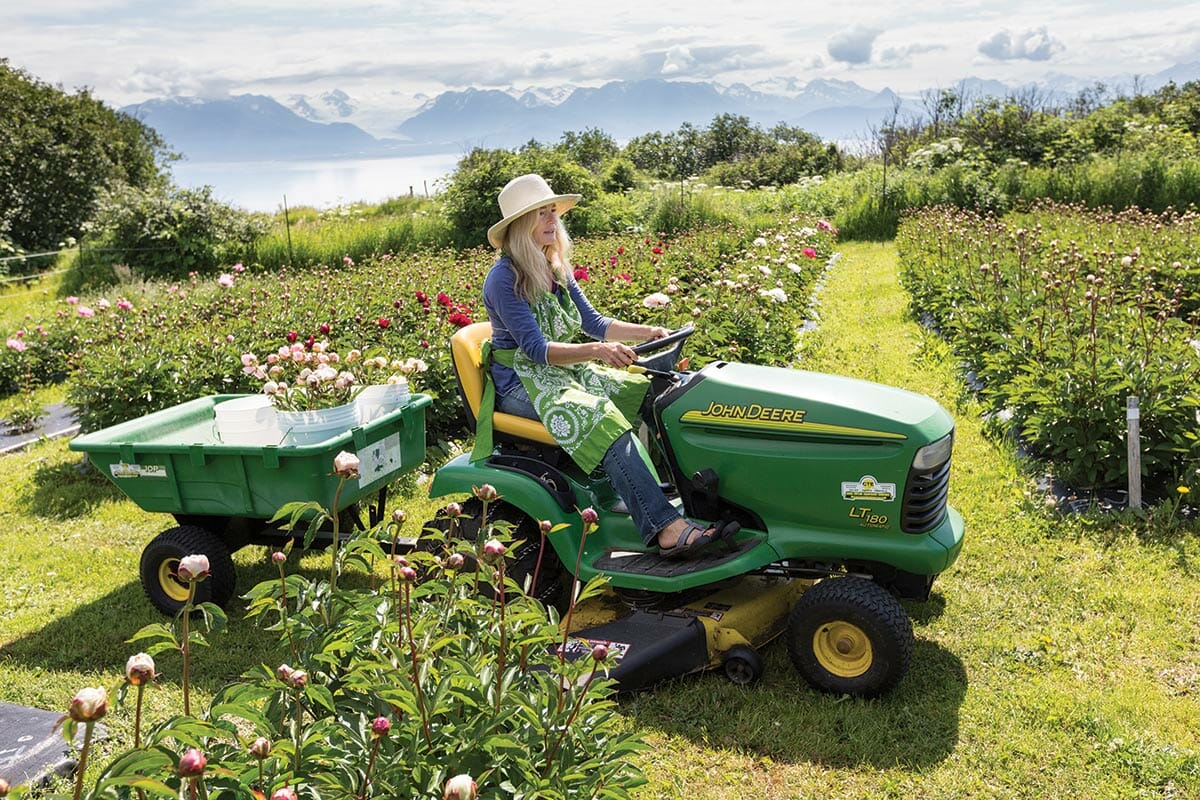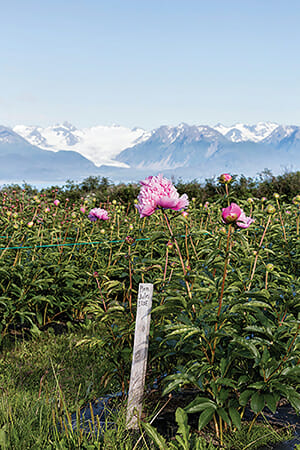From Fish to Flowers
Alaska’s new gold rush stems from beautiful peony flowers — ones that people will delay weddings over.
From Fish to Flowers
Alaska’s new gold rush stems from beautiful peony flowers — ones that people will delay weddings over.


The promise of gold, oil and king crab has lured fortune seekers to Alaska for decades. But Alaska’s newest profit-making industry stems from a most unusual source: flowers. Specifically, peonies – the kind that people will delay weddings over.
To date, over 100,000 roots have been planted in the state, and because peonies take years to mature, the industry is poised for steep growth. The projected harvest in 2017 is over 1 million stems, which could bring in somewhere between $4 to $5 million in sales. Still, this is a drop in the bucket compared to worldwide peony sales – Holland alone can sell over 30 million stems in a single month. But the northernmost state in the U.S. has one advantage over all other markets.
Alaska, it turns out, is one of the few places on Earth where peonies bloom in July.
“I got excited at this opportunity,” says Michelle LaFriniere of Chilly Root Peony Farm in Homer, Alaska. “We make compost with fish waste and seaweed. Our peonies are pampered princesses.”
The still-nascent peony boom was born in the late 1990s when a woman named Pat Holloway, director of the Georgeson Botanical Garden and professor at the University of Alaska, Fairbanks, gave a talk in Alaska about flowers. It was there that she learned about the seasonal anomaly from an audience member. (Holloway already knew that peonies require a winter hibernation.) They also don’t lend themselves well to container culture, which means that those big flower growers in Ecuador, Colombia and other tropical locales have a hard time growing peonies out of season. Add the fact that peonies can grow in temperatures of 60 degrees below zero with deep, insulating snowcover and Holloway had her eureka moment: Alaska could produce fresh-cut peony stems when they weren’t commercially available anywhere else. It was a potential cash cow.
The growing conditions aren’t just good in Alaska, they’re ideal. Due to the extended daylight during Alaskan summers – upwards of 20 hours of sun when the peonies are actively growing in June – flowers can grow as big as a human head.
The hue of Alaskan peonies ranges from buttery white to pale pink and magenta. The pink “Sarah Bernhardt,”’ a fragrant, double-petaled bloom, is one of the most popular in Alaska. But with over 3,000 types of peonies out there (including the “Pink Parfait,” “Princess Bride” and “Bowl of Beauty”), Alaskan growers are still busy testing newer varieties.
Alaska, as it turns out, is one of the few places on Earth where peonies bloom in July. This is prime wedding season.
Peonies are cut as tight buds that later open into frothy, effusive blooms. Representing romance, prosperity and good fortune worldwide, peonies have become the wedding flower.
Pat Holloway also happens to work for Alaska’s Agricultural and Forestry Experiment Station – a program jointly funded by the state and federal government to research agricultural development. She seized the opportunity with these showy blossoms, planting the first peonies in 2001 to suss out whether they could be grown for commercial purposes. She went on to create test sites in Kenai and Homer.
With many weddings happening between June and September, the fact that Alaska is one of the only places in the world where peonies bloom during this same window has been a huge boon to business. Alaska also happens to be an international cargo hub with regular flights from Anchorage to Europe, Asia and the continental U.S.
To complete this perfect storm, in 2009 a number of residents in Homer received grants to install “high tunnels,” greenhouse-like structures covered in clear polyethylene that extend the growing season. These were primarily intended for food production, but some farmers also use them for peonies.
Homer, Alaska, home to a number of peony farms, is located on the tip of the Kenai Peninsula in south-central Alaska, a 220-mile drive south of Anchorage. The town sits along the northern bench of Kachemak Bay, an awe-inspiring body of water with fjords and glaciers to the south. Homer has become as much a tourist destination as a fishing hub, with former halibut long-liners ferrying tourists in water taxis and fishwives running bed and breakfasts during the summer.
Measuring cut peonies at Chilly Root Farms. Most are cut at arm’s length, but some orders call for longer stems.
Beth VanSandt showing a flower bed she wants to cover, as this particular peony type catches too much water and can rot before fully opening.
Beth VanSandt takes her daily flower shipment to the local FedEx facility near Homer Airport.
Beth VanSandt runs Scenic Place Bed and Breakfast in Homer and her husband fishes nearby in Cook Inlet. ‘She started farming peonies on her 10.5 acres in 2010. Her first harvest came last year, producing 3,000 to 5,000 stems. “It takes three to four years before you can harvest peonies,” she explains. “They need to keep putting energy back into the roots, so you can’t harvest every bud – just five out of ten.” This year she plans on harvesting between 10,000 and 15,000.
VanSandt is ahead of the pack: Most of the growers in Alaska started in 2012, which means their flowers will be coming on the market in the next few years. “Right now the prices are stable,” she says, “but in three years, when all the new farms start selling, things could change.”
Other growers have a sunnier outlook. Shelley Rainwater owns Glacier Peonies in Homer, and has been working with other Kenai Peninsula growers to start a cooperative with a centralized sales and transportation hub. She doesn’t think it’s possible for Alaskan growers to flood the market.
“The Dutch can sell over 30 million stems in a 30-day window,” she says, “and with the increasing popularity of peonies, demand is only rising.”
Peony Primer
Peonies: Where do they come from? What are they good for? Here is an annotated list of the flower’s greatest moments.
*Peonies stretch back to ancient China, where, over a thousand years ago, they were cultivated for medicinal use.
*The modern U.S. peony industry can be traced to Amasa Kennicott selling peonies to local florists in Chicago in 1884. (Kennicott Brothers is now a major U.S. flower wholesaler, still based in Chicago.)
*According to Amy Pettit of the Alaska Division of Agricultural Marketing, peonies are a “very popular wedding and special event flower” because “they are big and smell good.”
*The top producers of peonies in the world are Chile, Israel, the Netherlands, the U.S. and New Zealand. The bloom times of these flowers are staggered to cover both the Christmas season rush, and the June and July rushes (wedding season).
*Prices of cultivars can range between $12 and $150 a root, depending on the variety.
*Wholesale, peonies rose in price from $1.89 for bunches of 10 in 1999 to $2.70 in 2005.
*The cut flower industry is worth an estimated $40 to $60 billion.
– Charles McFarlane
Follow us
This work is licensed under a Creative Commons Attribution-NoDerivatives 4.0 International License.
Want to republish a Modern Farmer story?
We are happy for Modern Farmer stories to be shared, and encourage you to republish our articles for your audience. When doing so, we ask that you follow these guidelines:
Please credit us and our writers
For the author byline, please use “Author Name, Modern Farmer.” At the top of our stories, if on the web, please include this text and link: “This story was originally published by Modern Farmer.”
Please make sure to include a link back to either our home page or the article URL.
At the bottom of the story, please include the following text:
“Modern Farmer is a nonprofit initiative dedicated to raising awareness and catalyzing action at the intersection of food, agriculture, and society. Read more at <link>Modern Farmer</link>.”
Use our widget
We’d like to be able to track our stories, so we ask that if you republish our content, you do so using our widget (located on the left hand side of the article). The HTML code has a built-in tracker that tells us the data and domain where the story was published, as well as view counts.
Check the image requirements
It’s your responsibility to confirm you're licensed to republish images in our articles. Some images, such as those from commercial providers, don't allow their images to be republished without permission or payment. Copyright terms are generally listed in the image caption and attribution. You are welcome to omit our images or substitute with your own. Charts and interactive graphics follow the same rules.
Don’t change too much. Or, ask us first.
Articles must be republished in their entirety. It’s okay to change references to time (“today” to “yesterday”) or location (“Iowa City, IA” to “here”). But please keep everything else the same.
If you feel strongly that a more material edit needs to be made, get in touch with us at [email protected]. We’re happy to discuss it with the original author, but we must have prior approval for changes before publication.
Special cases
Extracts. You may run the first few lines or paragraphs of the article and then say: “Read the full article at Modern Farmer” with a link back to the original article.
Quotes. You may quote authors provided you include a link back to the article URL.
Translations. These require writer approval. To inquire about translation of a Modern Farmer article, contact us at [email protected]
Signed consent / copyright release forms. These are not required, provided you are following these guidelines.
Print. Articles can be republished in print under these same rules, with the exception that you do not need to include the links.
Tag us
When sharing the story on social media, please tag us using the following: - Twitter (@ModFarm) - Facebook (@ModernFarmerMedia) - Instagram (@modfarm)
Use our content respectfully
Modern Farmer is a nonprofit and as such we share our content for free and in good faith in order to reach new audiences. Respectfully,
No selling ads against our stories. It’s okay to put our stories on pages with ads.
Don’t republish our material wholesale, or automatically; you need to select stories to be republished individually.
You have no rights to sell, license, syndicate, or otherwise represent yourself as the authorized owner of our material to any third parties. This means that you cannot actively publish or submit our work for syndication to third party platforms or apps like Apple News or Google News. We understand that publishers cannot fully control when certain third parties automatically summarize or crawl content from publishers’ own sites.
Keep in touch
We want to hear from you if you love Modern Farmer content, have a collaboration idea, or anything else to share. As a nonprofit outlet, we work in service of our community and are always open to comments, feedback, and ideas. Contact us at [email protected].by Maria Finn, Modern Farmer
September 16, 2014
Modern Farmer Weekly
Solutions Hub
Innovations, ideas and inspiration. Actionable solutions for a resilient food system.
ExploreExplore other topics
Share With Us
We want to hear from Modern Farmer readers who have thoughtful commentary, actionable solutions, or helpful ideas to share.
SubmitNecessary cookies are absolutely essential for the website to function properly. This category only includes cookies that ensures basic functionalities and security features of the website. These cookies do not store any personal information.
Any cookies that may not be particularly necessary for the website to function and are used specifically to collect user personal data via analytics, ads, other embedded contents are termed as non-necessary cookies.